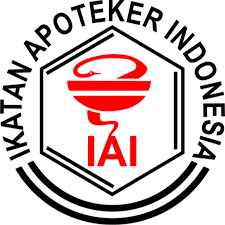Evaluasi Penggunaan Antibiotik pada Balita Penderita Pneumonia Rawat Inap di RSUD “Y” di Kota “X” Tahun 2016
Panji 'Utsman(1*), Hidayah Karuniawati(2)(1) Fakultas Farmasi Universitas Muhammadiyah Surakarta
(2) Fakultas Farmasi Universitas Muhammadiyah Surakarta
(*) Corresponding Author
Abstract
Pneumonia was pulmonary lung disease called parenchyma caused by microorganism, Pneumonia can be cured byantibiotic to prevent the resistantof bacteria and to improve the effective of the treatment, the right antibiotic must be determining. This research purpose is to determine the accuracy of using antibiotic in toddler patients suffering pneumonia who hospitalized in RSUD “Y” “X” City, in 2016. This is nonexperimental research. Data collected retrospectively and was analized descriptively. Samplestaken by purposive sampling method which searched the medical report of toddler patient suffer pneumonia hospitalized in RSUD “Y”X City, in 2016 which met the inclusion criteria. Reseach accuracy was analized used “Pedoman Pelayanan Medis Ikatan Dokter Anak Indonesia year 2009” and “British National Formularium for Children 2011-2012”, Such as indication accuracy, precision medicine accuracy, patient accuracy and drug dose accuracy. The result of the research was found that in 49 toddler patient suffering pneumonia, the kind of antibiotic used was cefotaxime (89,80%), Ampicillin (4,08%), combination of cefotaxime + gentamicin (4,08%) and ampicillin + gentamicin (2,04%). Evaluation of accuracy of the use antibiotic 100% right in indication, precision medicine by 93,87%,100% patient accuracy, and 10,20% drug dose accuracy.
Keywords
Full Text:
PDFReferences
Aurora, A.T., 2015. Evaluasi Ketepatan Antibiotik Pada Pasien Anak Terdiagnosa Pneumonia di RSUP Dr. Soeradji Tirtonegoro Klaten Tahun 2014 (Skripsi, Universitas Muhammadiyah Surakarta, Surakarta.
BMJ, 2011. BNF for Children 2011–2012, BMJ Group, Pharmaceutical Press, and RCPCH Publications Ltd, London.
Bradley J.S., Byington C.L., Shah S.S., Alverson B., Carter E.R., Harrison C., Kaplan S.L., Mace S.E., Jr G.H.M., Moore M.R., Peter S.D.S., StockwellJ.A. and Swanson J.T., 2011, The Management of Community-AcquiredPneumonia in Infants and Children Older Than 3 Months of Age: ClinicalPractice Guidelines by the Pediatric Infectious Diseases Society and the Infectious Diseases Society of America, Clinical Infectious Diseases, 1–52.
Bestari, M.P., Karuniawati, H., 2019. Evaluasi Rasionalitas dan Efektifitas Penggunaan Antibiotik pada Pasien Pneumonia Pediatrik di Instalasi Rawat Inap Rumah Sakit Pusat Jawa Tengah. Pharmacon: Jurnal Farmasi Indonesia 14, 62-71–71. https://doi.org/10.23917/pharmacon.v14i2.6524
Depkes Kota Magelang, 2014. Profil Kesehatan Kota Magelang Tahun 2014, Magelang, Dinkes Kota Magelang.
Depkes RI, 2008. Profil Kesehatan Indonesia, Jakarta, Depkes RI.
Dinkes Jawa Tengah, 2015. Profil Kesehatan Provinsi Jawa Tengah Tahun 2014, Semarang, Dinkes Provinsi Jawa Tengah.
Elorriaga, G.G. dan Del Rey-Pineda G., 2016. Basic Concepts on Community-Acquired Bacterial Pneumonia in Pediatrics, Pediatric Infectious Diseases: Open Access, Vol.1 No.1:3.
Gangil, J., Adhikari P., Sam K.G., Kumar A., Girish, Sanal, T.S., 2010. Evaluation of Azitromycin as add On Therapy in Community Acquired Pneumonia Patients: A Pilot Clinical Study, Journal of CurrentPharmaceutical Reasearch, 2(1), 15-20.
Harris M., Clark J., Coote N., Fletcher P., Harnden A., McKean M. and ThomsonA., 2011. Guidelines for the management of community acquired pneumoniain children: update 2011, BMJ Group, 66, 1–26.
IDAI, 2009. Pedoman Pelayanan Medis, Jakarta, IDAI.
Kemenkes RI, 2010. Modul Tatalaksana Standar Pneumonia, Jakarta, Kemenkes RI.
Kemenkes RI, 〖2011〗^a. Buku Panduan Hari Kesehatan Sedunia. Keputusan Menteri Kesehatan Tentang Standar Pelayanan Farmasi di Rumah Sakit. 2004. No 1197/MENKES/SK/X/2004.
Kemenkes RI, 〖2011〗^b,Pedoman Pelayanan Kefarmasian Untuk Terapi Antibiotik, Jakarta, Direktorat Jendral Bina Kefarmasian dan Alat Kesehatan.
Lima, E.J. da F., Mello, M.J.G., Albuquerque, M. de F.P.M. de, Lopes, M.I.L., Serra, G.H.C., Lima, D.E.P., Correia, J.B., 2016. Risk factors for community-acquired pneumonia in children under five years of age in the post-pneumococcal conjugate vaccine era in Brazil: a case control study. BMC Pediatr 16, 1–9. https://doi.org/10.1186/s12887-016-0695-6
Nurmala, Virgiandhy I.G.N, Adriani, Delima F, Liana, 2015. Resistensi danSensitivitas Bakteri terhadap Antibiotik di RSU dr. Soedarso Pontianak tahun2011-2013, Resistensi dan Sensitivitas Bakteri, Vol. 3, No. 1, halaman 21-27.
Ostapchuk M., Roberts D.M. and Haddy R., 2004. Community-Acquired Pneumonia in Infants and Children, American Family Physician, 70 (5),1–10.
PDPI, 2003. Pedoman Diagnosis dan Penatalaksanaan Pneumonia Komunitas di Indonesia, Jakarta: Perhimpunan Dokter Paru Indonesia.
Shah, G.S., Dutta, A.K., Shah, D., Mishra, O.P., 2012. Role of zinc in severe pneumonia: a randomized double bind placebo controlled study. Ital J Pediatr 38, 36. https://doi.org/10.1186/1824-7288-38-36
WHO, 2013. Pocket Book On Hospital Care for Children Guidlines for The Management of Common Childhood Illnesses, Second Edition. WHO Press, Switzerland
Article Metrics
Abstract view(s): 1225 time(s)PDF: 5889 time(s)
Refbacks
- There are currently no refbacks.








